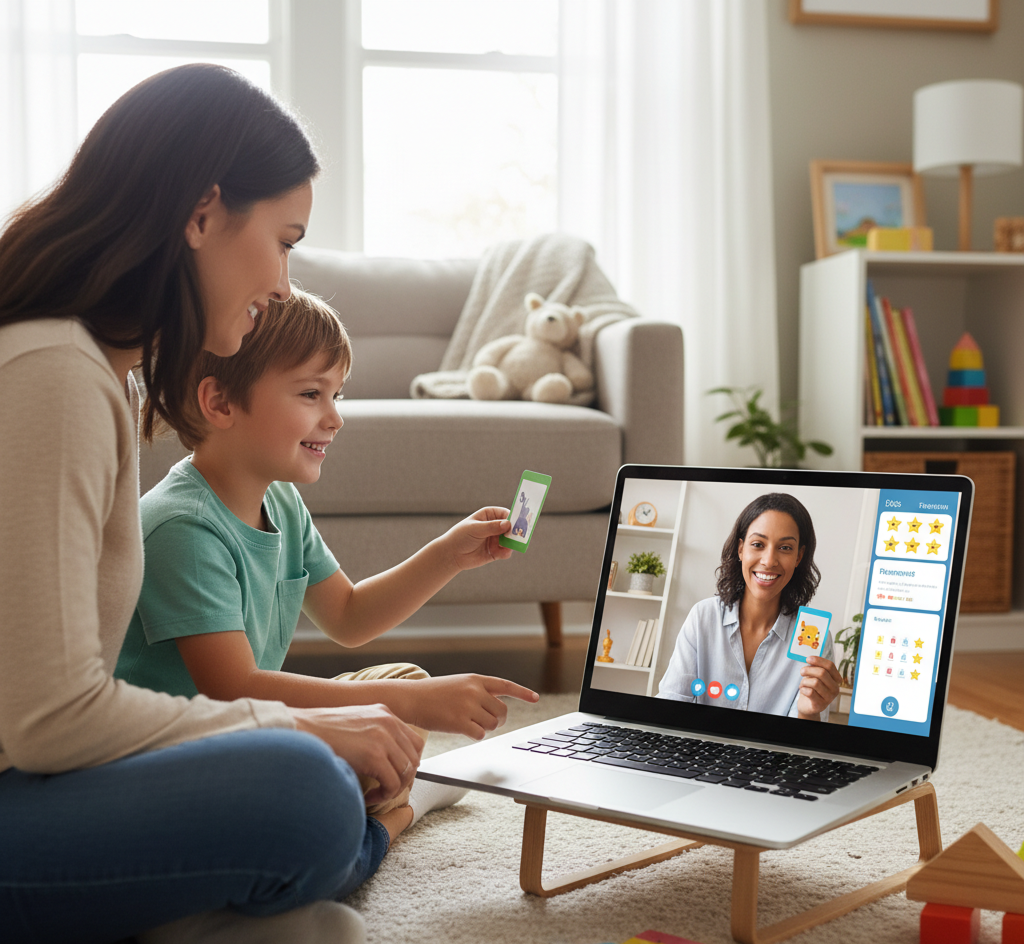Busting the Myths of Virtual ABA

Myth 1: "It's Not as Effective as In-Person Therapy"
The Reality: This is the biggest misconception, and the research doesn't support it.
Multiple studies confirm that telehealth ABA produces outcomes equivalent to traditional in-person services. A 2021 meta-analysis found that Virtual ABA achieved a 90% reduction in challenging behaviors, the same success rate as in-person therapy.
Why does it work so well? Because children are learning skills in their natural environment, where they'll actually use them. Skills learned at home during virtual sessions often generalize better to daily life than skills learned in a separate clinic setting.
Research published in the Journal of Autism and Developmental Disorders found equivalent gains in social and communication skills for children receiving Virtual ABA compared to in-person therapy.
Myth 2: "My Child Will Never Sit Still for a Computer"
The Reality: Virtual ABA isn't about parking your child in front of a screen.
Sessions are dynamic, play-based, and interactive. More importantly, with high parent-involvement models, you're on the floor with your child while the therapist coaches you through activities. The therapist might prompt your child to "touch the blue block," and you provide the physical guidance and reinforcement.
Many sessions involve real-life tasks like brushing teeth, putting away dishes, or practicing communication during snack time. The screen is simply the way your therapist connects with you. It's not the focus of the entire session.
Myth 3: "It's Just More 'Screen Time,' Which Is Bad"
The Reality: There's a critical difference between passive screen time and therapeutic engagement.
Watching cartoons or scrolling through videos is passive consumption. Virtual ABA is active, structured learning with a live clinician who's guiding your child through evidence-based interventions.
Think of it like the difference between watching a cooking show and taking a live cooking class with a chef. Both involve a screen, but only one is interactive, educational, and personalized to your needs.
Myth 4: "You Can't Build a Real Connection with a Therapist Over Video"
The Reality: Families build strong, supportive relationships with their virtual therapy teams all the time.
You meet with your BCBA and RBT consistently over live video. They get to know your child, your family dynamics, and your home environment intimately. Many parents report feeling more connected to their virtual team than they did with in-person providers because the therapist is focused entirely on them during sessions. No waiting room distractions or other families competing for attention.
The collaborative nature of virtual therapy actually deepens the relationship. You're working side-by-side with your clinician, learning together, and problem-solving in real-time.
Myth 5: "It Won't Work for My Child's Specific Needs"
The Reality: Virtual ABA is suitable for many children, though not all.
Virtual therapy works well for:
- Communication and language development
- Social skills training
- Daily living skills (toileting, dressing, mealtime behaviors)
- Reducing challenging behaviors that don't involve severe aggression or self-injury
- Parent training and coaching
It may not be the best fit for:
- Children with severe safety concerns requiring immediate physical intervention
- Families who can't commit to active participation in sessions
- Situations with very unstable internet or technology access
The only way to know for sure is through a clinical assessment. A qualified BCBA can evaluate your child's specific needs and determine if virtual therapy is appropriate.
Myth 6: "Insurance Won't Cover Virtual ABA"
The Reality: Many insurance plans, including Medicaid, now cover telehealth ABA services.
The COVID-19 pandemic accelerated insurance coverage for telehealth services, and many of those changes became permanent. Virtual ABA providers work with major commercial insurance plans and Medicaid programs across multiple states.
Coverage varies by state and plan, but it's absolutely worth checking. Many families are surprised to discover their insurance covers Virtual ABA just as it would traditional clinic-based services.
Myth 7: "Parents Have to Be the Therapist"
The Reality: You're an active participant, not the therapist.
This distinction is important. In high parent-involvement Virtual ABA models, you work collaboratively with the RBT during sessions. The therapist designs the activities, provides prompts, collects data, and guides the session. You implement the hands-on work under their direction.
You're learning strategies you can use throughout the day, but you're not responsible for creating treatment plans, analyzing data, or making clinical decisions. That's the BCBA's expertise.
Think of it like cooking with a professional chef. The chef designs the recipe and tells you exactly what to do next, but you're the one stirring the pot. You're learning skills, but you're not expected to be a professional chef.
The Bottom Line
Virtual ABA is a legitimate, research-backed service delivery model that's helping thousands of families access quality therapy. It's not a replacement for all in-person services, but for many families facing waitlists, distance, or scheduling barriers, it's an effective solution that delivers real results.
If you've been hesitant because of these myths, it might be worth taking a closer look. A clinical assessment can help you understand if Virtual ABA is right for your family's unique situation.
--
About Forta Health
Forta provides Online ABA Therapy for families who can't access traditional services due to waitlists, distance, or insurance barriers. We connect children with dedicated BCBAs and BTs through secure video sessions, enabling personalized therapy at home with active parent involvement. Making ABA therapy accessible for every family.
Available in 47 states and covered by Medicaid in 16 states, Forta eliminates waitlists so families can start therapy in 90 days on average. Learn more at fortahealth.com.
